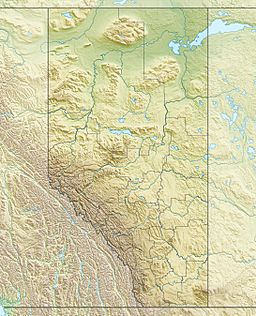Patricia Lake (Alberta) facts for kids
Quick facts for kids Patricia Lake / Lake Patricia |
|
|---|---|
 |
|
| Location | Jasper National Park, Alberta |
| Coordinates | 52°54′10″N 118°06′07″W / 52.90278°N 118.10194°W |
| Basin countries | Canada |
| Average depth | 30 metres (98 ft) |
| Surface elevation | c. 4,000 ft (1,200 m) |
Patricia Lake is a beautiful lake located in Jasper National Park, Alberta, Canada. It's found close to the town of Jasper. The lake was given its name in honor of Princess Patricia of Connaught, who was a granddaughter of Queen Victoria.
You can reach Patricia Lake by using Pyramid Lake road or by hiking on nearby trails. These paths also connect to other popular places like Pyramid Lake and Pyramid Mountain.
Contents
Secret World War II Project
Patricia Lake is famous for its special role during World War II. It was involved in a secret plan called Project Habbakuk. This project aimed to build a huge, unsinkable ship that could carry airplanes. It was going to be made from a special material called "Pykrete". Pykrete is a mix of ice and sawdust, which is much stronger than regular ice.
Scientists first tested natural lake ice at Lake Louise. Then, in January 1943, Patricia Lake was chosen as the perfect spot to build a test model of this amazing ship. The full-sized ship was planned to be about 600 meters (2,000 feet) long. The model built at Patricia Lake was much smaller, about 18 meters (60 feet) long.
Why Patricia Lake Was Chosen
Patricia Lake was picked for this important work for a few reasons:
- It had good rail connections to the town of Jasper, making it easy to bring in supplies.
- It was a cold, quiet area, far away from busy places.
- The area was already used for military training, so it was a good place to keep the project a secret.
- There were communities of Mennonite and Doukhobor people nearby. These groups had members who chose not to fight in the war due to their beliefs. They were able to help with the hard work needed for the project.
Building the Ice Ship
Construction of the model ship began in March 1943. Workers built a wooden cabin on the frozen lake. Inside, they put in special cooling equipment and a network of cold air ducts. They then built up the ice walls around the cabin, making the "hull" of the ship.
As the model grew heavier, the bottom part was carefully cut free from the lake ice. This allowed the model to float on its own. In June, the cooling system was turned off. Even without the cooling, the ice model lasted through the entire summer before it finally melted and sank.
Exploring the Remains
In 1985, a team of divers explored the site. They found the remains of the model ship on a steep slope underwater. It was at a depth of about 26 to 43 meters (85 to 140 feet).
The cooling equipment had been removed before the model sank. However, the wooden walls of the hull were still there. Divers also found a lot of the cold air ducts and a large amount of bitumen. Bitumen is a sticky, black substance used for insulation.
As of June 2011, only the west wall of the structure was still mostly together. The rest had broken into pieces and lay at depths of about 12 to 27 meters (40 to 90 feet). An underwater plaque at the site reminds visitors of its part in World War II history.
Today, recreational divers still visit the site to see the remains. However, the wreckage has been breaking down over the years. It has also unfortunately been damaged by people.



